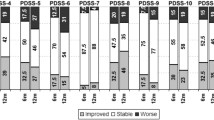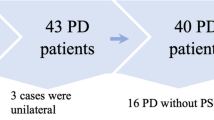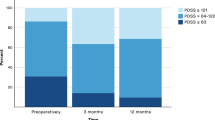Abstract
Sleep dysfunctions, including rapid eye movement sleep behavior disorder, sleep fragmentation, excessive daytime sleepiness and various other dysfunctions, can seriously affect quality of life in patients with Parkinson’s disease (PD). Emerging evidence suggests that deep brain stimulation (DBS) exerts a substantial effect when used to treat sleep dysfunctions, which are common nonmotor symptoms experienced by patients with PD. However, far less is known about the specific mechanisms underlying the effects of DBS on sleep processes and the factors that potentially influence these effects. These issues therefore need to be further clarified. Intriguingly, a number of recent studies have evaluated the effects of applying DBS to various brain targets on sleep in patients with PD. Deeper research into the efficacy of applying DBS to each brain target may help determine which region should be targeted during surgery in PD patients. Furthermore, compared with pharmacological therapy, DBS had more beneficial effects on sleep symptoms, and appropriate management involving the joint application of dopamine replacement therapy and DBS might accelerate the effects of treatment. Here, we review the potential roles DBS may play and provide clinical guidance for the use of DBS in treating sleep dysfunctions in PD patients.
Similar content being viewed by others
References
Schrempf W, Brandt MD, Storch A, Reichmann H (2014) Sleep disorders in Parkinson’s disease. J Parkinsons Dis 4:211–221
Olanow CW, Watts RL, Koller WC (2001) An algorithm (decision tree) for the management of Parkinson’s disease (2001): treatment guidelines. Neurology 56:S1–S88
Simuni T, Sethi K (2008) Nonmotor manifestations of Parkinson’s disease. Ann Neurol 64(Suppl 2):S65–S80
Tandberg E, Larsen JP, Karlsen K (1998) A community-based study of sleep disorders in patients with Parkinson’s disease. Mov Disord 13:895–899
Borek LL, Kohn R, Friedman JH (2006) Mood and sleep in Parkinson’s disease. J Clin Psychiatry 67:958–963
Scaravilli T, Gasparoli E, Rinaldi F, Polesello G, Bracco F (2003) Health-related quality of life and sleep disorders in Parkinson’s disease. Neurol Sci 24:209–210
Olanow CW, Stern MB, Sethi K (2009) The scientific and clinical basis for the treatment of Parkinson disease. Neurology 72:S1–S136
Pillai JA, Leverenz JB (2017) Sleep and neurodegeneration: a critical appraisal. Chest 151:1375–1386
Xie L, Kang H, Xu Q et al (2013) Sleep drives metabolite clearance from the adult brain. Science 342:373–377
Pahapill PA, Lozano AM (2000) The pedunculopontine nucleus and Parkinson’s disease. Brain 123:1767–1783
Braak H, Ghebremedhin E, Rüb U, Bratzke H, Del Tredici K (2004) Stages in the development of Parkinson’s disease-related pathology. Cell Tissue Res 318:121–134
Wetter TC, Collado-Seidel V, Pollmächer T, Yassouridis A, Trenkwalder C (2000) Sleep and periodic leg movement patterns in drug-free patients with Parkinson’s disease and multiple system atrophy. Sleep 23:361–367
Adler CH (2005) Nonmotor complications in Parkinson’s disease. Mov Disord 20:S23–S29
Kales A, Ansel RD, Markham CH, Scharf MB, Tan TL (1971) Sleep in patients with Parkinson’s disease and normal subjects prior to and following levodopa administration. Clin Pharmacol Ther 12:397–406
Brunner H, Wetter TC, Hogl B, Yassouridis A, Trenkwalder C, Friess E (2002) Microstructure of the non-rapid eye movement sleep electroencephalogram in patients with newly diagnosed Parkinson’s disease: effects of dopaminergic treatment. Mov Disord 17:928–933
Adler CH, Thorpy MJ (2005) Sleep issues in Parkinson’s disease. Neurology 64:S12–S20
Schrag A, Sauerbier A, Chaudhuri KR (2015) New clinical trials for nonmotor manifestations of Parkinson’s disease. Mov Disord Sep 30:1490–1504
Dong J, Cui Y, Li S, Le W (2016) Current pharmaceutical treatments and alternative therapies of Parkinson’s disease. Curr Neuropharmacol 14:339–355
Volkmann J, Albanese A, Kulisevsky J et al (2009) Long-term effects of pallidal or subthalamic deep brain stimulation on quality of life in Parkinson’s disease. Mov Disord 24:1154–1161
Rodrigues JP, Walters SE, Watson P, Stell R, Mastaglia FL (2007) Globus pallidus stimulation improves both motor and nonmotor aspects of quality of life in advanced Parkinson’s disease. Mov Disord 22:866–870
Arnulf I, Bejjani BP, Garma L et al (2000) Improvement of sleep architecture in PD with subthalamic nucleus stimulation. Neurology 55:1732–1734
Litvinenko IV, Krasakov IV, Tikhomirova OV (2012) Sleep disorders in Parkinson’s disease without dementia: a comparative randomized controlled study of melatonin and clonazepam. Zh Nevrol Psikhiatr Im S S Korsakova 112:26–30
Trenkwalder C, Kies B, Rudzinska M et al (2011) Rotigotine effects on early morning motor function and sleep in Parkinson’s Disease: a double-blind, Randomized, Placebo-Controlled Study (RECOVER). Mov Disord 26:90–99
Eggert K, Öhlwein C, Kassubek J et al (2014) Influence of the nonergot dopamine agonist piribedil on vigilance in patients with Parkinson disease and excessive daytime sleepiness. Clin Neuropharmacol 37:116–122
Zibetti M, Rizzone M, Merola A et al (2013) Sleep improvement with levodopa/carbidopa intestinal gel infusion in Parkinson disease. Acta Neurol Scand 127:e28–e32
Kulua TK, Fedorova NV, Popovkina OA (2011) Nocturnal motor symptoms of Parkinson’s disease and their treatment with the three-component drug levodopa/carbidopa/entacapone. Zh Nevrol Psikhiatr Im S S Korsakova 111:45–50
Rios Romenets S, Creti L, Fichten C et al (2013) Doxepin and cognitive behavioural therapy for insomnia in patients with Parkinson’s disease—a randomized study. Parkinsonism Relat Disord 19:670–675
Di Giacopo R, Fasano A, Quaranta D, Della Marca G, Bove F, Bentivoglio AR (2012) Rivastigmine as alternative treatment for refractory REM behavior disorder in Parkinson’s disease. Mov Disord 27:559–561
Lotan I, Treves TA, Roditi Y, Djaldetti R (2014) Cannabis (medical marijuana) treatment for motor and non-motor symptoms of Parkinson disease. Clin Neuropharmacol 37:41–44
Ricciardi L, De Nigris F, Specchia A, Fasano A (2015) Homotaurine in Parkinson’s disease. Neurol Sci 36:1581–1587
Gallagher DA, Lees AJ, Schrag A (2010) What are the most important nonmotor symptoms in patients with Parkinson’s disease and are we missing them? Mov Disord 25:2493–2500
Iranzo A, Valldeoriola F, Santamaria J, Tolosa E, Rumia J (2002) Sleep symptoms and polysomnographic architecture in advanced Parkinson’s disease after chronic bilateral subthalamic stimulation. J Neurol Neurosurg Psychiatry 72:661–664
Hwynn N, Ul Haq I, Malaty IA, Resnick AS, Dai Y, Foote KD (2011) Effect of deep brain stimulation on Parkinson’s nonmotor symptoms following unilateral DBS: a pilot study. Parkinsons Dis 2011:507416
Amara AW, Standaert DG, Guthrie S, Cutter G, Watts RL, Walker HC (2012) Unilateral subthalamic nucleus deep brain stimulation improves sleep quality in Parkinson’s disease. Parkinsonism Relat Disord 18:63–68
Lyons KE, Pahwa R (2006) Effects of bilateral subthalamic nucleus stimulation on sleep, daytime sleepiness, and early morning dystonia in patients with Parkinson disease. J Neurosurg 104:502–505
Monaca C, Ozsancak C, Jacquesson JM et al (2004) Effects of bilateral subthalamic stimulation on sleep in Parkinson’s disease. J Neurol 251:214–218
Arnulf I, Bejjani BP, Garma L et al (2000) Effect of low and high frequency thalamic stimulation on sleep in patients with Parkinson’s disease and essential tremor. J Sleep Res 9:55–62
Chahine LM, Ahmed A, Sun Z (2011) Effects of STN DBS for Parkinson’s disease on restless legs syndrome and other sleep-related measures. Parkinsonism Relat Disord 17:208–211
Aravamuthan BR, Muthusamy KA, Stein JF, Aziz TZ, Johansen-Berg H (2007) Topography of cortical and subcortical connections of the human pedunculopontine and subthalamic nuclei. Neuroimage 37:694–705
Lu J, Sherman D, Devor M, Saper CB (2006) A putative flip-flop switch for control of REM sleep. Nature 441:589–594
Parent A, Hazrati LN (1995) Functional anatomy of the basal ganglia. II. The place of subthalamic nucleus and external pallidum in basal ganglia circuitry. Brain Res Brain Res Rev 20:128–154
Bevan MD, Bolam JP (1995) Cholinergic, GABAergic, and glutamate-enriched inputs from the mesopontine tegmentum to the subthalamic nucleus in the rat. J Neurosci 15:7105–7120
Amara AW, Watts RL, Walker HC (2011) The effects of deep brain stimulation on sleep in Parkinson’s disease. Ther Adv Neurol Disord 4:15–24
Azmi H, Gupta F, Vukic M et al (2016) Interventional magnetic resonance imaging-guided subthalamic nucleus deep brain stimulation for Parkinson’s disease: patient selection. Surg Neurol Int 7:S557–S563
Profice P, Mazzone P, Pilato F et al (2011) Neurophysiological evaluation of the pedunculopontine nucleus in humans. J Neural Transm (Vienna) 118:1423–1429
Wang XH, Zhang L, Sperry L et al (2015) Target selection recommendations based on impact of deep brain stimulation surgeries on nonmotor symptoms of Parkinson’s disease. Chin Med J (Engl) 128:3371–3380
Qiu MH, Yao QL, Vetrivelan R, Chen MC, Lu J (2016) Nigrostriatal dopamine acting on globus pallidus regulates sleep. Cereb Cortex 26:1430–1439
Kovac S, Wright MA, Eriksson SH, Zrinzo L, Matharu M, Walker MC (2014) The effect of posterior hypothalamus region deep brain stimulation on sleep. Cephalalgia 34:219–223
Lim AS, Moro E, Lozano AM et al (2009) Selective enhancement of rapid eye movement sleep by deep brain stimulation of the human pons. Ann Neurol 66:110–114
Peppe A, Pierantozzi M, Baiamonte V et al (2012) Deep brain stimulation of pedunculopontine tegmental nucleus: role in sleep modulation in advanced Parkinson disease patients: one-year follow-up. Sleep 35:1637–1642
Garcia-Rill E, Luster B, D’Onofrio S, Mahaffey S, Bisagno V, Urbano FJ (2015) Pedunculopontine arousal system physiology-Deep brain stimulation (DBS). Sleep Sci 8:153–161
Deuschl G, Schade-Brittinger C, Krack P et al (2006) A randomized trial of deep-brain stimulation for Parkinson’s disease. N Engl J Med 355:896–908
Hjort N, Østergaard K, Dupont E (2004) Improvement of sleep quality in patients with advanced Parkinson’s disease treated with deep brain stimulation of the subthalamic nucleus. Mov Disord 19:196–199
Rye DB (1997) Contributions of the pedunculopontine region to normal and altered REM sleep. Sleep 20:757–788
Kedia S, Moro E, Tagliati M, Lang AE, Kumar R (2004) Emergence of restless legs syndrome during subthalamic stimulation for Parkinson disease. Neurology 63:2410–2412
Cicolin A, Lopiano L, Zibetti M et al (2004) Effects of deep brain stimulation of the subthalamic nucleus on sleep architecture in parkinsonian patients. Sleep Med 5:207–210
Baumann-Vogel H, Imbach LL, Sürücü O et al (2017) The impact of subthalamic deep brain stimulation on sleep-wake behavior: a prospective electrophysiological study in 50 Parkinson patients. Sleep 40:zsx033
Hashimoto T, Elder CM, Okun MS, Patrick SK, Vitek JL (2003) Stimulation of the subthalamic nucleus changes the firing pattern of pallidal neurons. J Neurosci 23:1916–1923
Kita H, Tachibana Y, Nambu A, Chiken S (2005) Balance of monosynaptic excitatory and disynaptic inhibitory responses of the globus pallidus induced after stimulation of the subthalamic nucleus in the monkey. J Neurosci 25:8611–8619
Miocinovic S, Parent M, Butson CR et al (2006) Computational analysis of subthalamic nucleus and lenticular fasciculus activation during therapeutic deep brain stimulation. J Neurophysiol 96:1569–1580
Hahn PJ, Russo GS, Hashimoto T et al (2008) Pallidal burst activity during therapeutic deep brain stimulation. Exp Neurol 211:243–251
Qiu MH, Chen MC, Wu J, Nelson D, Lu J (2016) Deep brain stimulation in the globus pallidus externa promotes sleep. Neuroscience 322:115–120
Qiu MH, Vetrivelan R, Fuller PM, Lu J (2010) Basal ganglia control of sleep-wake behavior and cortical activation. Eur J Neurosci 31:499–507
Chen MC, Ferrari L, Sacchet MD et al (2015) Identification of a direct GABAergic pallidocortical pathway in rodents. Eur J Neurosci 41:748–759
Borgohain R, Kandadai RM, Jabeen A, Kannikannan MA (2012) Nonmotor outcomes in Parkinson’s disease: is deep brain stimulation better than dopamine replacement therapy? Ther Adv Neurol Disord 5:23–41
Pahwa R, Stacy MA, Factor SA et al (2007) EASE-PD Adjunct Study Investigators. Ropinirole 24-hour prolonged release: randomized, controlled study in advanced Parkinson disease. Neurology 68:1108–1115
Vignatelli L, Billiard M, Clarenbach P et al (2006) EFNS guidelines on management of restless legs syndrome and periodic limb movement disorder in sleep. Eur J Neurol 13:1049–1065
Winkelman JW, Sethi KD, Kushida CA et al (2006) Efficacy and safety of pramipexole in restless legs syndrome. Neurology 67:1034–1039
Stiasny-Kolster K, Kohnen R, Schollmayer E, Moller JC, Oertel WH, Rotigotine Sp 666 Study Group (2004) Patch application of the dopamine agonist rotigotine to patients with moderate to advanced stages of restless legs syndrome: a double-blind, placebo-controlled pilot study. Mov Disord 19:1432–1438
Walters AS, Ondo WG, Dreykluft T, Grunstein R, Lee D, Sethi K (2004) Ropinirole is effective in the treatment of restless legs syndrome. TREAT RLS 2: a 12-week, double-blind, randomized, parallel- group, placebo controlled study. Mov Disord 19:1414–1423
Micallef J, Rey M, Eusebio A et al (2009) Antiparkinsonian drug-induced sleepiness: a double-blind placebo-controlled study of l-dopa, bromocriptine and pramipexole in healthy subjects. Br J Clin Pharmacol 67:333–340
Ferreira JJ, Galitzky M, Montastruc JL, Rascol O (2000) Sleep attacks and Parkinson’s disease treatment. Lancet 355:1333–1334
Schapira AHV (2000) Sleep attacks (sleep episodes) with pergolide. Lancet 355:1332–1333
Frucht S, Rogers JD, Greene PE, Gordon MF, Fahn S (1999) Falling asleep at the wheel: motor vehicle mishaps in persons taking pramipexole and ropinirole. Neurology 52:1908–1910
Allen RP, Earley CJ (1996) Augmentation of the restless legs syndrome with carbidopa/levodopa. Sleep 19:205–213
Rukmini Mridula K, Borgohain R et al (2015) Comparison of frequencies of nonmotor symptoms in Indian Parkinson’s disease patients on medical management versus deep brain stimulation: a case–control study. Iran J Neurol 14:86–93
Acknowledgements
This work was supported by the Program of Individualized Diagnosis and Treatment of Parkinson’s Disease and Related Dyskinesia and Construction of Neural Regulation Platform (LNCCC-C06-2015), and the Integrated Research Project of New Diagnosis and Treatment Technology of Electrical Stimulation of Brain Implantation (2016YFC0105900).
Funding
This study was funded by the Program of Individualized Diagnosis and Treatment of Parkinson’s Disease and Related Dyskinesia and Construction of Neural Regulation Platform (LNCCC-C06-2015), and the Integrated Research Project of New Diagnosis and Treatment Technology of Electrical Stimulation of Brain Implantation (2016YFC0105900).
Author information
Authors and Affiliations
Corresponding authors
Ethics declarations
Conflict of interest
The authors declare no competing financial interests.
Ethical approval
This article does not contain any studies with human participants performed by any of the authors.
Informed consent
For this type of study written formal consent is not required.
Rights and permissions
About this article
Cite this article
Zou, S., Lan, YL., Hu, YP. et al. Update on the clinical application of deep brain stimulation in sleep dysfunction of Parkinson’s disease. Acta Neurol Belg 118, 351–359 (2018). https://doi.org/10.1007/s13760-018-0971-3
Received:
Accepted:
Published:
Issue Date:
DOI: https://doi.org/10.1007/s13760-018-0971-3




